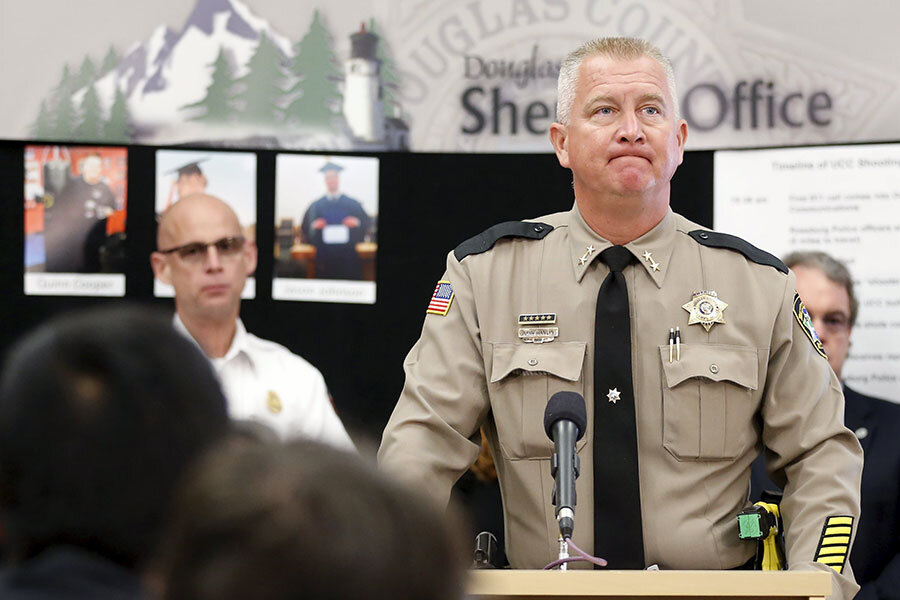Oregon town answers shooter's hate with silence
Loading...
Douglas Country Sheriff John Hanlin would not say his name: “I will not give him the credit he probably sought prior to this horrific and cowardly act.” The Portland Oregonian newspaper has said it will use the name only when necessary. And on Twitter, a hashtag has sprung up: #dontsayhisname.
In the aftermath of tragedy, the people of Roseburg, Ore., want the attention to be on the names and stories of the nine people killed at Umpqua Community College Thursday. To use the name of the suspected killer, who killed himself when found by police, would be to give him his wish, they say – to make him notorious.
As Americans struggle to come to terms with mass shootings – both their frequency and their emotional toll – Roseburg has highlighted one approach: Try to take away the dark glamour that draws some individuals to desperate and cruel acts. One recent study suggests that mass shootings do create a copycat effect.
The issue not just about naming suspects, but about how their stories are told and how widely, the research suggests. Mass shootings lie at the nexus of easy access to guns, mental illness, and a thirst for notoriety, experts say. What Roseburg has done is a step toward undermining the allure of mass killings, but it also indicates that going further requires a more fundamental change.
Sheriff Hanlin’s move is not unprecedented. A police chief in Washington State would not identify a 15-year-old boy who killed himself and four friends last year, and a sheriff in suburban Denver would not name a high-schooler who killed himself and a classmate in 2013, according to the Associated Press.
The suspect in the Umpqua Community College shootings noted the impact of the media. When a Virginia journalist killed two people live on television in August, a post on a Facebook page connected with the suspect said: "I have noticed that so many people like him are all alone and unknown, yet when they spill a little blood, the whole world knows who they are."
That was the conclusion of a study released in July by Sherry Towers, a research professor at Arizona State University in Tempe. She found that mass shootings that resulted in three or fewer deaths had no copycat effect. When four or more people were killed, however, Professor Towers found that there was an elevated chance of copycat mass killings for 13 days.
The difference? When four people were killed, she surmised, there was more national media attention.
The study did not prove the correlation between national media coverage and the elevated risk of copycat mass killings. Nor did it diminish the importance of access to guns or the lack of access to adequate mental-health care, which have repeatedly been connected to mass shootings as major factors. But many experts believe the media do play an important role, as well.
Take the example of the manifestos often produced by mass killers. "If you stand back and treat it with awe, then you’re giving it more power than it should have," Ari Schulman, executive editor of the New Atlantis, told the Monitor after the Charleston church shootings.
It is that tone, ultimately, that mass killers want to inspire, psychologists say. So reporting on mass killings should deny them that sense of power, they add.
That includes accounts of the suspect’s arsenal and stories about victims’ families, said sociologist Zynep Tufkeci in a 2012 article for The Atlantic. Such stories only add to “the sense of spectacle and trauma,” she writes.
Not releasing the suspect’s name is one of her steps.
Yet not conveying information to the public can also be damaging, some say.
Knowing the names “and their histories lets us better understand the larger social patterns, policies and tensions leading up to their crimes,” Vanderbilt University professor Jonathan Metzl told AP.
When the New York Daily News put pictures of the Virginia journalist firing his gun on its front page, Shane Ryan of Paste Magazine in part defended the newspaper against the “bizarre, pervasive concept that if we hide from the images of something horrific, we can pretend that it never actually happened.”
But media coverage can have an effect on copycat crime, according to a seminal 20-year-old study. Amid a rash of suicides on Vienna subways in the 1980s, local media began desensationalizing coverage, including moving stories to inside pages and not using “suicide” in the headlines. Suicides dropped 75 percent.
Arizona State’s Towers said of her recent study to CNN: "What we believe may be happening is national news media attention is like a 'vector' that reaches people who are vulnerable."
[Editor's note: The original sub-headline of the story misstated the number of people killed.]






